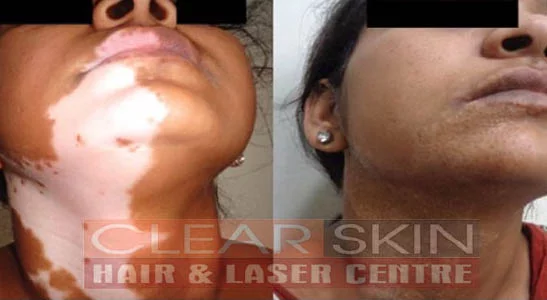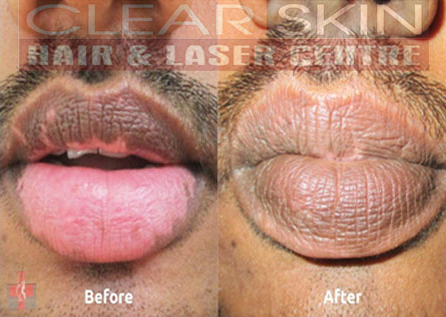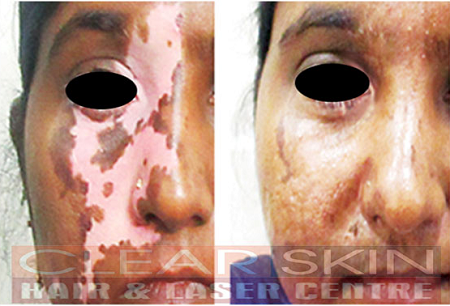Vitiligo is an autoimmune, acquired skin pigmentation disorder, characterized by milky-white or discolored patches, single or multiple on any part of the body.These patches gradually increase in size & cause a lot of psychological stress in the patient. The reason behind this pigmentation is due to the progressive destruction of color-producing cells of the skin called melanocytes.
Vitiligo is a non-contagious disease, neither life-threatening or nor a medical disorder.
Vitiligo is also known as ‘white spot’ or ‘leucoderma’ in India, it is considered as a social stigma.
Segmental Vitiligo-appear as unilateral patches in a segmental or band-shaped distribution.
Non-segmental Vitiligo-appear as bilateral symmetrical patches often distributed in an acrofacial pattern involving mostly the exposed area of skin such as face, neck, and hands or scattered symmetrically all over the body. It is the most common type of vitiligo, found in 90% of cases.
This is the most common type of non-segmental vitiligo, is not confined to a certain specific area.
This involves the face and acral areas such as fingers or toes.
This appears mostly around the mucous membranes and lips.
This occurs extremely rare, and the depigmented patches cover most of the body.
One or a few scattered discrete patches of white patches develop and are mostly found in young children.
Vitiligo is due to the progressive destruction of color-producing cells of the skin called melanocytes. The reason behind the destruction of melanocytes is not completely understood. It is understood that immunological factors play an important role due to its high association with other autoimmune diseases like diabetes, thyroid disorders, lupus, alopecia areata, etc.
The autoimmune disease in which the body’s own immune system attacks, by producing a protein called cytokines that destroys the skin cells called melanocytes present in the upper layer of skin.
The hereditary factor may have a role, but only 30% of people have a family history of vitiligo.
Other factors such as genes and neurological or combination of all these three, may play a role in causing vitiligo.In fact, some say that any kind of trauma (physical, mechanical, chemical, emotional) can trigger this de-pigmentation process.
Topical medication: such as topical corticosteroid and most recently used topical calcineurin inhibitors (tacrolimus, pimecrolimus) are most commonly used to achieve repigmentation.
Systemic Medication: to be added if topical therapy fails to respond or in whom the condition is progressing rapidly. Immunosuppressive drugs such as oral corticosteroid or methotrexate or azathioprine or psoralens and sunlight exposure ( PUVAsol therapy) may be useful.
If Conservative treatment fails, we may need interventional treatment such as phototherapy or surgery to restore the color.
Interventional Phototherapy: In the majority of cases phototherapy is helpful to restore the pigment; and in limited stable vitiligo, not responding to conventional treatment, repigmentation can be achieved by 308 Excimer and or with surgery.
Phototherapy is further divided depending upon the area of exposure and the band of light used.
Conventional Phototherapy:In this phototherapy process, we expose the patient to a whole body or specific areas such as hand & foot to artificial Ultraviolet A & Ultraviolet B rays. This treatment process may take about 4 to 6 months.
Narrow Band UVB:Here the light is emitted in a narrow band portion of the UVB light range, and has been shown to stop or slow the progression of active vitiligo. It might be more effective when used with corticosteroids or calcineurin inhibitors.
Psoralen +UVA called as photochemotherapy: This treatment combines a plant-derived substance called psoralen with UVA light therapy to re-pigment the color. After you take psoralen by mouth or apply it to the affected skin, you’re exposed to ultraviolet A (UVA) light. Psoralen is known to increase the skin’s sensitivity to UV light, including sunlight.
Targeted phototherapy: Targeted phototherapy is an exciting new technology that seeks to overcome some of the disadvantages with conventional phototherapy. This modality involves the application of light energy directly focused on or targeted at the lesion through special delivery mechanisms.
The main advantages are safety, ease of administration, and suitability for difficult to treat areas and in children.
Daavlin Lumera: The world’s most advanced treatment with specific ultraviolet wavelength targeting the only affected skin without involving surrounding skin. It is most effective, quick, and needs only a few treatment sessions once in four or seven days.
308 Excimer system: is a handheld system that uses the most advanced semi-laser technology which delivers a perfect and stable NBUVB light beam for treating autoimmune diseases of the skin such as vitiligo and psoriasis. The system enables you to apply high, therapeutically-effective doses of monochromatic UVB light while leaving healthy skin unexposed and protected. UVB radiation has an immune-modeling effect which can normalize pathologically altered cellular activities.
If phototherapy and medications haven’t worked, some patients with stable and limited disease can best opted for surgery; during which a very small section of your healthy pigmented skin is transferred to areas that have lost pigment. Though there a possible risks which include infection, scarring, a cobblestone appearance, spotty color, and failure of the area to recolor.
There are different techniques of skin grafting mentioned below such as:
Miniature Punch Grafting (MPG): is done by using a biopsy punch (sizes of 1, 1.5, 2, or 2.5 mm) from the normally pigmented skin(usually from the external part of thighs) and grafting them in the appropriately punch out chambers at recipient vitiligenous site. Basically, this is a kind of skin implant. After 4 to 6 weeks we can notice the change in color of the white patch.
Suction Blister Grafting (SBG): This may also be called a re-pigmentation process. In this procedure, the blisters are created on a donor or pigmented skin using suction. The discolored or recipient area of skin is dermabraded or laser-ablated and the top of the blister is transplanted to the vitiligenous site. After two weeks to one month of the procedure, we can observe the change in color gradually.
Ultrathin split-thickness skin grafting: In this procedure, we extract a thin graft (containing the epidermis and the uppermost part of dermis) from the external parts of the thigh of the patient and preserve it in a tray containing normal saline. After that, the white patch is dermabraded or laser-ablated and covers with the preserved thin graft. After two weeks to one month of the procedure, we can observe the change in color gradually.
Non-cultured melanocyte transplant or Cellular suspension transplant: This is a simple, outpatient procedure, in which the skin graft is taken from the pigmented skin, put into several solutions or medium to get a rich yield of melanocytes. The separated melanocytes are transplanted to the dermabraded or laser-ablated area of vitiligenous site and bandaged with a collagen sheet. The repigmentation starts within four weeks of the procedure.
Micropigmentation: Micropigmentation is a technique in which minute, metabolically inert pigment granules are implanted below the epidermis for cosmetic and/or corrective enhancement. The process can be performed in vitiligo involving lips, areola, in less than two hours.
Depigmentation treatment: in those patients with extensive vitiligo with leftover few patches of pigmentation. The skin bleaching with depigmenting cream or cryotherapy or with laser therapy with Q-switched may be used.
As the latest equipment or technology and advanced treatment are the demands of the time.
We at Clear Skin Centre bring to you these all at one place, the most advanced, up-to-the-date world’s best technology, and enabling to treat the vitiligo problem under one roof. In fact, if you go on comparing, you will find that we have some of the most popular equipment that is widely used in most of the well-advanced countries.
| DO | DON'T |
|---|---|
| Use physical sun-protection like umbrella, wear full sleeves clothing | Do not exposure to direct sunlight |
| Use a broad-spectrum sunscreen (SPF>30) | Do not do sun-bathing |
| Use cotton fabrics that absorb moisture | Do not wear synthetic fiber clothes |
| Use natural oils to maintain moisture | Do not use rubber made items, hair dyes, lipsticks or perfumes |
| Use regular moisturizerss | Do not smoke or drink alcohol |
| Join support groups | Do not get tattoos |
| Do yoga or meditation to reduce psychological stress | Do not eat unhealthy food |
| Do not isolate yourself |



